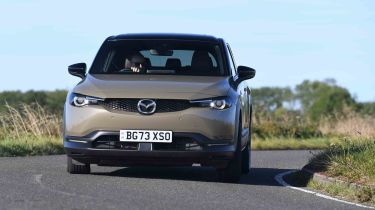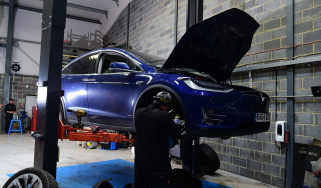Mazda MX-30 - Electric motor, drive and performance
The MX-30 is fun to drive for an EV, but the heavier R-EV is a little disappointing

Both versions of the MX-30 have the same powertrain set-up: a front-mounted electric motor with a battery pack under the floor. Depending on which model you choose, you get a 35.5kWh battery in the full EV, or a 17.8kWh unit in the R-EV. The EV’s battery is on the small side so the car’s range isn’t great, but that version is aimed at those with a short commute.
If you need more range, then the R-EV model adds a rotary engine under the bonnet plus a 50-litre fuel tank so that the smaller battery can be recharged when on the move. This boosts the MX-30’s range to more than 400 miles.
The rotary engine will be familiar to fans of Mazda’s sports cars. It uses an oval-shaped combustion chamber with a rounded-triangle that rotates within it. Where a piston in a normal engine goes up and down with explosions that are converted mechanically to a rotational force, rotary engines spin around a central point and are super-smooth as a result.
It means you get hardly any vibration, even at high revs, which is a great way to charge a battery as a generator. The MX-30’s R-EV set-up works in the same way as the old BMW i3 REx range extender, where the wheels are only ever driven by the electric motor, and the engine comes on automatically to charge the battery when it’s needed.
Used - available now

2020 Mazda
Mx-30
18,937 milesAutomaticElectric
Cash £10,748
2023 Mazda
Mx-30
25,052 milesAutomaticElectric
Cash £11,535
2020 Mazda
Mx-30
26,018 milesAutomaticElectric
Cash £11,703
2020 Mazda
Mx-30
35,678 milesAutomaticElectric
Cash £10,135While the R-EV model is a bit heavier than the pure-EV MX-30, it’s also more powerful. The EV has 143bhp to offer, but the range extender increases that to 168bhp.
|
Model |
Power |
0-62mph |
Top speed |
|
MX-30 EV |
143bhp |
9.7 seconds |
87mph |
|
MX-30 R-EV |
168bhp |
9.1 seconds |
87mph |
What is the Mazda MX-30 like to drive?
The Mazda MX-30 is a composed car with a fine balance of comfort and handling, just like pretty much every other Mazda. It’s clear as soon as you get behind the wheel that the brand takes the driving experience seriously because the MX-30 is comfortable and smooth, has excellent control weights and a great driving position, while it also has a classy, high-quality feel.
In town
The MX-30 rides well over bumps, and the comfortable driving position means you won’t feel anything but the worst potholes around town. The electric motor is quiet and getting up to 40mph or so is swift, although the 0-62mph time of 9.1 seconds shows that once you’re above that, acceleration drops off quite a bit. It’s not slow, but other EVs and hybrids offer better acceleration up to the national speed limit.
The main issue with the MX-30 R-EV is that although the rotary engine is smooth and free from vibration, it’s noisy. It doesn’t sound appealing like the old rotaries in Mazda sports cars, but just reminds us of a generator motor at a fairground. It whirrs away in the background with a droning tone. Considering how quiet the rest of the experience is, it’s noticeable when it starts charging the battery.
The electric parking brake has an auto-hold function and comes on automatically when you shift into park. However, it doesn’t automatically disengage when you try to pull away, which is a quirk that takes some getting used to.
On A- and B-roads
At higher speeds, the R-EV’s motor is drowned out by wind and road noise, although those aren’t much of an issue in the MX-30 overall. Rather, you’ll start to enjoy the car’s well-weighted steering and smooth ride, as country roads are where it excels.
On twisty roads, the Electric G-Vectoring Control Plus (e-GVC Plus) system works away in the background, adjusting the electric motor’s torque to aid handling. Combined with good reserves of grip, the MX-30 feels reassuringly stable and easy to place.
It’s no sports car, but the Mazda is satisfying to drive, with good body control through corners despite the soft suspension. The regenerative braking feels natural and you’ll hardly notice it doing its job because the pedal feel is pretty good at all times.
There are differing intensities on offer that are adjusted via the steering wheel paddle shifters. The car’s braking performance generally feels very natural, with predictable stopping power and pedal feel, while the graduated modes are never jerky and mean you can set a level of regenerative braking you’re comfortable with. None of the settings have the one-pedal driving strength of Nissan’s e-Pedal system – even the highest setting.
On the motorway
While the electric motor starts to feel a bit weedy at higher speeds, that’s no issue in the MX-30 R-EV for motorway driving; it’s as good as it needs to be. The ride is smooth at high speed, and wind and road noise are tolerable – it’s not noticeably hushed at 70mph, but nor is it particularly noisy.
0-62mph acceleration and top speed
With 143bhp on tap and 271Nm of torque, the all-electric MX-30 can sprint from 0-62mph in 9.7 seconds and has a top speed of 87mph. That’s fast enough acceleration for most needs, but if you want more, then the R-EV has 168bhp and 260Nm of torque (in part to help compensate for the extra weight of the hybrid powertrain) and can sprint from 0-62mph in 9.1 seconds. The top speed of this version is also 87mph.








